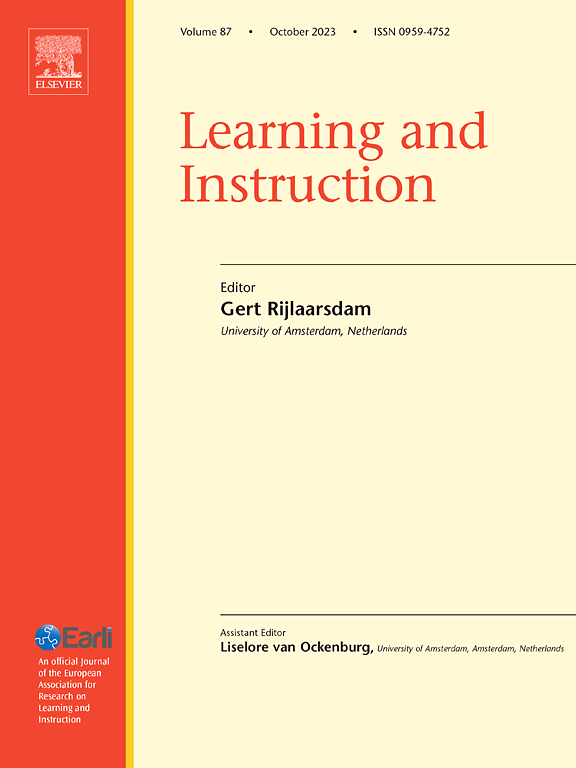Putting excellence first: How rubric performance level order and feedback type influence students’ reading patterns and task performance
IF 4.9
1区 教育学
Q1 EDUCATION & EDUCATIONAL RESEARCH
引用次数: 0
Abstract
Background
Rubrics are structured assessment tools that describe criteria and levels of performance, helping students understand expectations and improve their work. They are widely used to support learning in educational settings. However, little is known about how students process rubrics in real time, and empirical research on rubric design and feedback effects is limited.
Aim
This study examines how university students engage with rubrics during two landscape analysis tasks, focusing on two variables: the order of performance levels (highest first vs. last) and the type of feedback received (no feedback [control], process-based, product-based, or rubric-based). By combining eye-tracking and think-aloud protocols, the study offers a multimodal perspective on students’ visual attention and cognitive engagement.
Sample
Eighty undergraduate students from six degree programs were randomly assigned to one of four feedback conditions.
Methods
A randomized controlled trial was conducted. Eye-tracking data—fixation times, number of visits, and gaze transitions—and verbal data from think-aloud protocols were collected across task phases. Integrating these process-tracing methods enabled detailed analysis of how students interacted with the rubric and how engagement related to performance.
Results
Students focused primarily on the highest performance level, especially when it appeared first. Visual attention to this level predicted task performance; verbal references did not. Rubric-based feedback increased visual alignment between rubric and task, while process-based feedback led to the strongest performance gains.
Conclusion
Rubric design and feedback type significantly influence student engagement and performance. Eye-tracking and think-aloud data provide complementary insights, reinforcing rubrics’ instructional value when paired with targeted feedback.
以卓越为先:标题成绩等级顺序和反馈类型对学生阅读模式和任务表现的影响
标准是描述标准和表现水平的结构化评估工具,帮助学生理解期望并改进他们的工作。它们被广泛用于支持教育环境中的学习。然而,关于学生如何实时处理题型的研究很少,关于题型设计和反馈效果的实证研究也很有限。目的:本研究考察了大学生在两项景观分析任务中如何使用规则,重点关注两个变量:表现水平的顺序(最高的第一个vs.最后一个)和收到的反馈类型(无反馈[控制],基于过程的,基于产品的,或基于规则的)。通过结合眼球追踪和有声思考协议,该研究为学生的视觉注意力和认知参与提供了一个多模式的视角。样本来自6个学位项目的80名本科生被随机分配到4个反馈条件中的一个。方法采用随机对照试验。眼动追踪数据——注视时间、访问次数和凝视转换——以及来自有声思考协议的口头数据在任务阶段被收集。整合这些过程跟踪方法,可以详细分析学生如何与主题互动,以及参与度如何与绩效相关。结果:学生们主要关注的是最高的表现水平,尤其是当它出现在第一个时。该水平的视觉注意预测任务表现;口头推荐则不然。基于规则的反馈增加了规则和任务之间的视觉一致性,而基于过程的反馈导致了最强的性能提升。结论题目设计和反馈类型对学生的参与和表现有显著影响。眼球追踪和有声思维数据提供了互补的见解,当与有针对性的反馈相结合时,强化了规则的教学价值。
本文章由计算机程序翻译,如有差异,请以英文原文为准。
求助全文
约1分钟内获得全文
求助全文
来源期刊

Learning and Instruction
Multiple-
CiteScore
11.30
自引率
4.80%
发文量
109
期刊介绍:
As an international, multi-disciplinary, peer-refereed journal, Learning and Instruction provides a platform for the publication of the most advanced scientific research in the areas of learning, development, instruction and teaching. The journal welcomes original empirical investigations. The papers may represent a variety of theoretical perspectives and different methodological approaches. They may refer to any age level, from infants to adults and to a diversity of learning and instructional settings, from laboratory experiments to field studies. The major criteria in the review and the selection process concern the significance of the contribution to the area of learning and instruction, and the rigor of the study.
 求助内容:
求助内容: 应助结果提醒方式:
应助结果提醒方式:


